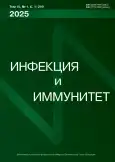Proinflammatory cytokine production by adherent donor blood cells stimulated by soluble LPS and phagocyted bacteria
- 作者: Lysakova E.V.1, Rybtsov S.A.1, Toshchakov V.Y.1
-
隶属关系:
- Sirius University of Science and Technology
- 期: 卷 15, 编号 1 (2025)
- 页面: 178-184
- 栏目: SHORT COMMUNICATIONS
- URL: https://journal-vniispk.ru/2220-7619/article/view/292142
- DOI: https://doi.org/10.15789/2220-7619-PCP-17752
- ID: 292142
如何引用文章
全文:
详细
Specific stimulation of receptors of the innate immune system by their purified ligands is commonly used in basic studies of inflammation and in the development of anti-inflammatory drugs. Based on location, receptors of the innate immunity can be classified into two groups: i) cell plasma membrane and on membranes of endosomes (Toll-like receptors (TLRs) and C-type lectin receptors), and recognizing the presence of pathogens in the extracellular space; ii) cytoplasmic sensors playing a special role in the recognition of intracellular pathogens (NOD-like receptors (NLRs), RIG-I-like receptors (RLRs), bacterial DNA sensor cGAS, and Aim2 (absent in melanoma 2). Many experimental models of inflammation use bacterial lipopolysaccharides (LPSs) or other purified microbial molecules to simulate the innate immune response to microbes. In the present study, the response of human blood leukocytes to stimulation with soluble, highly purified LPS from gram-negative bacteria was compared with that induced by formalin-fixed, corpuscular E. coli. The data obtained demonstrate that LPS and bacteria induce similar levels of TNF and IL-6 by plastic-adherent leukocytes, whereas neither LPS nor whole bacteria induce a measurable IFNγ production. The LPS- and bacteria-induced cytokine production, however, drastically differed in the sensitivity to a broad-spectrum TLR inhibitor, peptide 5R667. The LPS-stimulated human leukocyte cytokine production, as expected, was highly sensitive to inhibition by the peptide, whereas production stimulated by corpuscular bacteria was not. The TLR-blocking peptide did not affect the ability of blood leukocytes to phagocytose E. coli as shown by flow cytometry data obtained using FITC-stained fixed bacteria. Because peptide 5R667 blocks several TLRs, including TLR4, TLR5, and TLR9, the differential sensitivity of LPS- and bacteria-induced cytokine production to 5R667 suggests that the intracellular pathogen sensors, most likely NOD1 and/or NOD2, essentially contribute to the bacteria-induced cytokine induction. These results show that LPS and phagocyted bacteria induce cytokine production via different mechanisms and also suggest that the models with corpuscular bacteria for simulating bacterially induced inflammation complement the models that using soluble TLR ligands; therefore, both models should be applied to properly reflect anti-bacterial immune response.
作者简介
E. Lysakova
Sirius University of Science and Technology
Email: toschakov.vy@talantiuspeh.ru
PhD Student
俄罗斯联邦, Sirius Federal Territory, Krasnodar RegionS. Rybtsov
Sirius University of Science and Technology
Email: toschakov.vy@talantiuspeh.ru
PhD (Biology), Head of the Resource Center for Cell Technologies and Immunology
俄罗斯联邦, Sirius Federal Territory, Krasnodar RegionVladimir Toshchakov
Sirius University of Science and Technology
编辑信件的主要联系方式.
Email: toschakov.vy@talantiuspeh.ru
PhD (Medicine), Leading Researcher, Division of Immunobiology and Biomedicine
俄罗斯联邦, Sirius Federal Territory, Krasnodar Region参考
- Elinav E., Strowig T., Henao-Mejia J., Flavell R.A. Regulation of the antimicrobial response by NLR proteins. Immunity, 2011, vol. 34, pp. 665–679. doi: 10.1016/j.immuni.2011.05.007
- Fu Y.L., Harrison R.E. Microbial phagocytic receptors and their potential involvement in cytokine induction in macrophages. Front. Immunol., 2021, vol. 12: 662063. doi: 10.3389/fimmu.2021.662063
- Janeway C.A., Medzhitov R. Innate immune recognition. Annu. Rev. Immunol., 2002, vol. 20, pp. 197–216. doi: 10.1146/annurev.immunol.20.083001.084359
- Javmen A., Zou J., Nallar S.C., Szmacinski H., Lakowicz J.R., Gewirtz A.T., Toshchakov V.Y. TLR5-derived, TIR-interacting decoy peptides to inhibit TLR signaling. J. Immunol., 2023, vol. 210, pp. 1419–1427. doi: 10.4049/jimmunol.2200394
- Kawai T., Akira S. Toll-like receptors and their crosstalk with other innate receptors in infection and immunity. Immunity, 2011, vol. 34, pp. 637–650. doi: 10.1016/j.immuni.2011.05.006
- Keestra-Gounder A.M., Tsolis R.M. NOD1 and NOD2: beyond peptidoglycan sensing. Trends Immunol., 2017, vol. 38, pp. 758–767. doi: 10.1016/j.it.2017.07.004
- Lysakova E.V., Shumeev A.N., Chuvpilo S.A., Laktyushkin V.S., Arsentieva N.A., Bobrov M.Y., Rybtsov S.A. Quantitative analysis of phagocytosis in whole blood using double staining and visualization. Biochemistry (Moscow), 2024, vol. 89, pp. 923–932. doi: 10.1134/S0006297924050122
- Núñez G. Intracellular sensors of microbes and danger. Immunol. Rev., 2011, vol. 243, pp. 5–8. doi: 10.1111/j.1600-065X.2011. 01058.x
- Ogura Y., Inohara N., Benito A., Chen F.F., Yamaoka S., Núñez G. Nod2, a Nod1/Apaf-1 family member that is restricted to monocytes and activates NF-κB. J. Biol. Chem., 2001, vol. 276, pp. 4812–4818. doi: 10.1074/jbc.M008072200
- Sundaram B., Tweedell R.E., Prasanth Kumar S., Kanneganti T.D. The NLR family of innate immune and cell death sensors. Immunity, 2024, vol. 57, pp. 674–699. doi: 10.1016/j.immuni.2024.03.012
- Toshchakov V.Y. Peptide-based inhibitors of the induced signaling protein interactions: current state and prospects. Biochemistry (Moscow), 2024, vol. 89, pp. 784–798. doi: 10.1134/S000629792405002X
- Toshchakov V.Y., Javmen A. Targeting the TLR Signalosome with TIR domain-derived cell-permeable decoy peptides: the current state and perspectives. Innate Immun., 2020, vol. 26, pp. 35–47. doi: 10.1177/1753425919844310
- Toshchakov V., Jones B.W., Perera P.Y., Thomas K., Cody M.J., Zhang S., Williams B.R.G., Major J., Hamilton T.A., Fenton M.J., Vogel S.N. TLR4, but Not TLR2, Mediates IFN-β-induced STATIα/β-dependent gene expression in macrophages. Nat. Immunol., 2002, vol. 3, no. 4, pp. 392–398. doi: 10.1038/ni774
- Toshchakov V.Y., Neuwald A.F. A survey of TIR domain sequence and structure divergence. Immunogenetics, 2020, vol. 72, pp. 181–203. doi: 10.1007/s00251-020-01157-7
- Zhou H., Coveney A.P., Wu M., Huang J., Blankson S., Zhao H., O’Leary D.P., Bai Z., Li Y., Redmond H.P., Wang J.H., Wang J. Activation of both TLR and NOD signaling confers host innate immunity-mediated protection against microbial infection. Front. Immunol., 2019, vol. 9: 3082. doi: 10.3389/fimmu.2018.03082
补充文件









